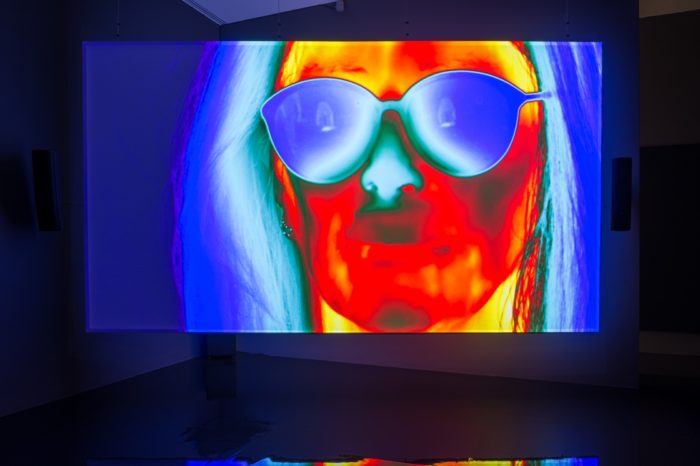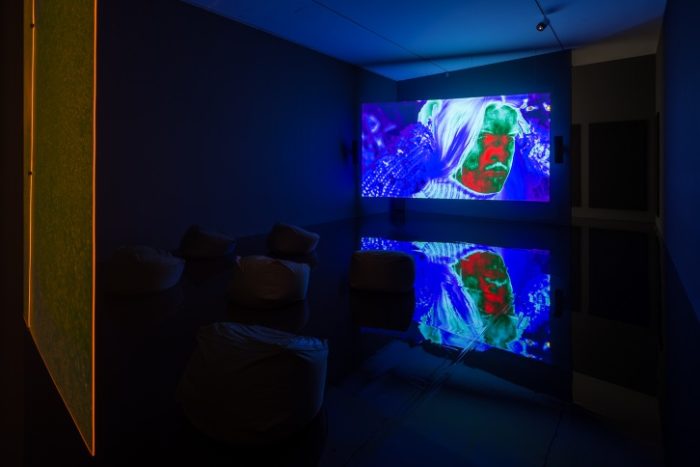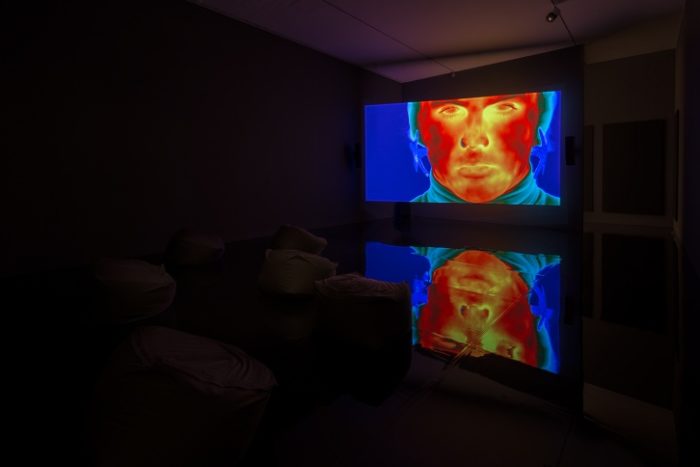Since the Ancient Greek word phármakon can mean both ‘remedy’ and ‘poison,’ the word’s actual meaning can only be ascertained contextually. The English term ‘pharmacology’ is derived from phármakon and arguably shares some of its ambiguity. Which of a drug’s effects are intended and which are unintended, and at what point do the side-effects become so severe they no longer justify the intended ones? Patrick Staff grapples with such questions in ‘Weed Killer,’ their most recent video installation showing at New Museum from September 27 to January 21. The title is borrowed from Catherine Lord’s 2004 experimental narrative The Summer of Her Baldness, wherein the author graphically describes taking chemotherapy drugs as “mainlining weed killer.”

Weed Killer revolves around a monologue adapted from Lord’s memoir, performed by transgender actress Debra Soshoux. The transposition of words from Lord to Soshoux shifts our attention to the drugs many trans people take during gender confirmation therapy and some continue for their entire lives. By bringing these two experiences into dialogue, Staff opens up the possibility of other comparisons, stretching from the powerful pharmaceuticals used to treat psychosis and epilepsy to supposedly more mundane antidepressants and birth control pills. While the medical-industrial complex has the power to legitimate, the long-term consequences of its interventions remain unclear, especially when it comes to cancer.
In addition to Soshoux’s monologue, ‘Weed Killer’ contains a lip-synched performance by transgender artist Jamie Crewe in a gay bar. Despite her passionate delivery, the bar’s cis gay male patrons largely ignore her, gesturing towards another agentive limit: other people. “I’m only as much as you allow me to be,” Staff says in the following interview at their Echo Park studio on an especially hot July afternoon, while ‘Weed Killer’ is still showing at MOCA in July. While those of us with access to healthcare have the privilege of deciding whether to take a drug, none of us can control how others will respond to us.
Finally, Weed Killer includes infrared thermography of Soshoux, Crewe, and Staff, revealing invisible gradations across and around these bodies. This strange imagery seems to ask, ‘What else might we be unaware of in our bodies? And how do drugs interact with this internal architecture?’ This interview with Patrick Staff ranges broadly over these and related topics, such as how they came to be making this work and what it means to represent the pain of others. The resultant text consists less of definitive answers and more of attempts to understand what it means to live and love in the age of Big Pharma.
** I thought we could start with a description of Weed Killer.
Patrick Staff: There are a few different threads of my practice and lived experience, that fed into the making of this work. There’s, of course, the ‘below deck’ answer, wherein I talk about sickness in my own life.
For a long time I was making work about communities and collectives. My interest was always circling around when a real bid for freedom would curve into conservatism. I’ve since moved more towards thinking about relations to power as ecological.
Catherine Lord and I came to know each other when I asked her to write for an artist book. I went back to her memoir, The Summer of Her Baldness, which deconstructs and reconstitutes gender, sickness, the body, and community. I wanted to articulate and explore a transfeminine identity through the text, to pry open its possible interpretations, and began to translate sections into a monologue. Having a dialogue with Catherine, but also the performers in the video, particularly Debra, the lead actor, became really important in the process, too.
When we talk about making work about health, sickness, debility, we’re often in these positions—the cleaner, above board answer as to why this, why now, and the dirtier, messier question of the lived reality of our bodies.

** For me, Weed Killer challenges the idea that technology will free us and suggests technology is actually disciplining us.
PS: This line of questioning in my work definitely came from dance. In Weed Killer, I was interested in exploring the potential ways disciplinary structures are formed in the body, are reproduced or inhabit it. And to really lean into where desire, love, or passion might factor into this. Where contamination might flourish.
Jasbir Puar’s work became important here—negotiating the fraught relationship between transness and disability. That dance work I mentioned was negotiating a training of the body into recreating an abled body, not only in terms of gender and sexuality, but also in terms of economic productivity. For Puar, it’s about exploring the trans relation to disability as not being one only of pathologisation, but about the trans body being transformed, in tandem with many other types of bodies, from incapacitated to viable neoliberal subjects.
I think at this point, people are understanding transness isn’t a recent phenomenon, that trans people have always existed. But we forget the pathologised trans subject—in terms of the DSM-5 or the ADA, but also the ways people attach the trans subject to hormones, surgery, prosthetics—is very recent. And from here we can talk about how the body functions as a nexus of various cross-contaminations, such as the racialised nature of toxicity, environmental endocrine disruption, the sexing of pollution, and the ensuing collapse of the American economy were a cancer cure ever found.
**Weed Killer plays with continuous and dichotomous modes of categorization. We can think about medicine as having a dichotomizing function (i.e., you have cancer or you don’t). And while measures like blood pressure exist along a continuum, there are thresholds defining what is ‘normal.’ Weed Killer contains thermal imaging, which shows the body as being both continuous and discrete.
PS: I wanted to needle that state of you-either-are-or-you-aren’t. That might be as simple as my entire childhood and adolescence, being constantly, aggressively demanded to declare whether I was a boy or a girl. But there is also the above deck response, about how when we speak about identity we can talk about the medical model, the legislative model, the social model. This idea comes from critical disability studies. But it has an interesting relationship to transness. Am I trans in the eyes of the law, in the box I tick on a form? In my doctor’s eyes, am I trans enough to be deserving of hormones? Do I pass on the street? There are many moments in the video where states of being are disrupted. The thermal mapping in the video creates a sort of disidentification. The camera we used, and the technician who came with it, work predominantly in the medical and engineering worlds. That technology is used to detect inflammation in the body, tumours, etcetera, and in factories it’s used to find malfunction, overheated machinery. We were, in a way, deliberately misusing this technology. I think for most of us, that type of imagery more directly references surveillance and warfare.

** Do you think the rise of trans visibility has affected your work? Like the medical-industrial complex validating certain individuals, media outlets choose to portray some trans people rather than others. These choices might prove to be quite consequential for those who aren’t knowingly friends with trans people, since the media could then be their only source of information.
PS: In my personal life, I’m proximate to a lot of that stuff. I have a huge amount of respect and admiration for the artists and activists involved. I think sometimes a blanket critique of this moment is a cop out. It challenges me and I appreciate that. I don’t quite think I have the optimism for it, but I certainly recognize that my work operates in tandem with it. I’m happy to be able to deviate from it, question it, or twist the knife.
**Do you think that’s why you’re attracted to video as a medium? While video captures an actual world, painting shows a possible one. Filming dance records something happening through the body.
PS: There’s always been something parasitic about my practice. When I was in art school, I was really interested in appropriation and New Narrative. A lot of Kathy Acker. I was fixated on accounts of her death from cancer. So from there, I’ve always taken images or form, genre, or language and troubled them, infected them. And that’s something I really like about film—it’s such a dominant language, so pervasive and persuasive. Both ‘The Foundation’ and ‘Weed Killer’ have a strong sense of genre gone awry, or of a trusting form— particularly documentary or naturalistic performance—deliberately made uneasy. I still love dance, for the same reasons—whether eating into the structure of ballet or modern dance, or using pedestrian movement and stylised gesture. Curdling it, letting something ‘wrong’ enter into the frame.
** Is there something that you want viewers of Weed Killer to come away with? Are you trying to draw parallels between different experiences or is your goal just to provoke? It seems you’ve given some attention to reception insofar as you’ve provided seats.
PS: For a long time the work I made would deliberately keep the viewer at arm’s length. I’m not so interested in that anymore. I actually want you to be comfortable, I want you to want to be here. It’s a deliberate choice for it to be an installation you can enter into, you lounge and get low, and let the bass rattle your chest. That’s how you become complicit in the work, when you get a sense of your own body, and from there it pushes back at you, vibrates you.
** That relationship between artist and viewer became important in recent conversations about the Whitney Biennial and who has a ‘right’ to represent others. In both Weed Killer and ‘The Foundation’ you have certain characteristics you share with the people you represent and others differentiating you.
PS: For sure. And I think a big part of Weed Killer was, ‘how do we articulate pain, who gets to articulate pain and to whom?’ I wanted the juxtaposition of the bar scene to redirect the energy of the monologue in some way. That first section of the video, Debra is speaking so intensely about her chemotherapy, her body, to the audience. She’s self-possessed and angry, but also has a wry, guarded sense of humor. I wanted to contrast that with a club scene where Jamie projects in a completely different way, equally if not more passionately, to a group of uninterested people. She’s singing about how it’s possible to feel almost addicted to another person, how it’s burning her up inside. And yet there’s no reciprocity from the men watching her. The audience is pulled in a very different way by that style of performance, the club singer who is singing about her love and heartbreak. Who is able to articulate pain, who receives this articulation and how?

And that really comes out of a gendered experience. In both The Foundation and Weed Killer, there’s transfemininity in relation to groups of cis gay men. There’s a proximity between those identities, but also a moment when solidarity easily collapses.
I come back around to the social model of sickness or gender; a questioning of whether I’m only as much as you allow me to be, and what defines those terms. We are very much conditioned into dichotomies; sick or healthy, man or woman.
** Perhaps dance is a good way of getting at that because it’s an activity you could do. In his work, Tino Sehgal often invites spectators to participate and then sees whether they choose to engage. Some older modes of using the body in art like performance, however, still rely upon a break between performer and audience that dance perhaps bridges.
PS: For a long time I was invested in more collective ways of working, other ways of bringing audiences into projects, but I became dissatisfied with the sense of assumed or inherent optimism, whether just from myself or in the frameworks, institutions, or funding that made that type of work possible. I’m interested in murkier territory. I’ve often said Weed Killer doesn’t have a straightforward sense of kinship, between Catherine and I, transness and cancer; no one’s coming out of it clean, no one’s coming out of it lighter in any way. I don’t want to alleviate pressure in my work, I’d rather we’re all stained by the experience.
** While consumers of fiction and cinema usually expect some semblance of a narrative, art has the privilege of being able to just pull things together and let them vibrate. There’s a certain generosity of art viewers, who are willing to be unsettled, though it’s always a question of how far you can push that.
PS: Something that came up a lot in making this work were the anxieties and superstitions that cancer invokes. There were days when my research was spread all over my kitchen table and my boyfriend would say he just didn’t want to see those books that day. In rehearsals, Debra said she felt she was summoning or invoking cancer into her body through performing the monologue. People asked, jokingly, if I thought I could give myself cancer working on the subject. All of this points to how cancer occupies a very particular social and cultural space.
I’m drawn towards agitations, rather than operating from a position of desiring clarification. Asking more questions than it answers is a hokey way of talking about one’s art practice, but I question myself a lot; ‘is this generous, is this responsible, is this productive?’













